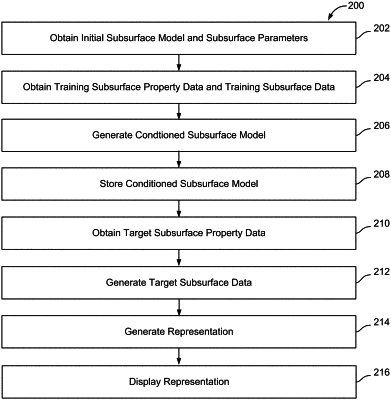| CPC G01V 1/306 (2013.01) [E21B 47/003 (2020.05); G06F 18/214 (2023.01); G06F 18/2415 (2023.01)] | 17 Claims |

|
1. A computer-implemented method for training a subsurface model to generate subsurface data as a function of position and time in a subsurface volume of interest, the method being implemented in a computer system that includes a physical computer processor, a display, and electronic storage, the method comprising:
obtaining, from the electronic storage, a first training subsurface dataset comprising a first set of subsurface energy values obtained at a first set of times from a first set of field data sensors located at a first set of positions, and a first set of subsurface property values corresponding to the first set of subsurface energy values;
obtaining, from the electronic storage, a first initial subsurface model and a first set of subsurface parameters based on a first set of subsurface relationships between the first training subsurface dataset and the first set of subsurface property values;
determining (i) training subsurface property data from changes to the first set of subsurface property values as a function of position and time and (ii) changes to the first set of subsurface energy values as a function of position and time, wherein position and time are determined from the first set of positions and the first set of times, respectively;
generating, with the physical computer processor, a first conditioned subsurface model by training the first initial subsurface model using the training subsurface property data, the first training subsurface dataset, and the changes to the first set of subsurface energy values as a function of position and time;
storing the first conditioned subsurface model in the electronic storage;
obtaining, from the electronic storage, a first target subsurface dataset comprising a second set of subsurface energy values obtained at a second set of times from a second set of field data sensors located at a second set of positions in the subsurface volume of interest, and a second set of subsurface property values corresponding to the second set of subsurface energy values;
determining changes to the second set of subsurface property values as a function of position and time in the subsurface volume of interest;
generating, with the physical computer processor, a first target subsurface property dataset based on the second set of subsurface energy values as a function of position and time in the subsurface volume of interest by applying the first conditioned subsurface model to the first target subsurface dataset;
generating a representation of the first target subsurface dataset as a function of position and time in the subsurface volume of interest using visual effects to depict at least some of the first target subsurface dataset as a function of position and time; and
displaying the representation via the display.
|